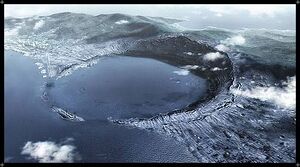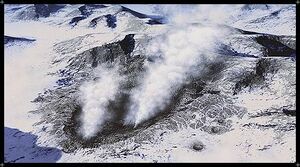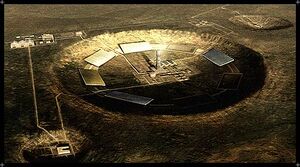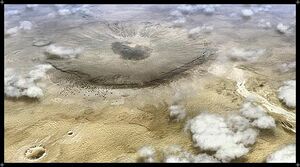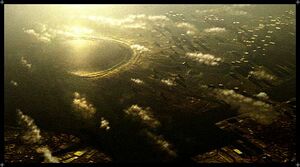Craters
Craters was a World News article published by Color of the World on April 10, 2003. It focused on craters left behind on the Usean continent by the Ulysses 1994XF04 asteroid.[1] Below is a translation of the original text.[2]
Introduction
It's been four years since Ulysses arrived in our solar system. This asteroid fell to earth in countless fragments, leaving countless scars across the world. However, today many people dedicate their lives indefatigably to raising awareness for reconstruction, and everywhere their will is beginning to take form.
At the same time, it seems as though the craters, which themselves speak witness to this seminal tragedy, are themselves inexorably changing. A curtain is falling on an era, and perhaps this will bring change to many people's lives as well. However, we must learn from this reality. Meteorite impacts are an astronomical event which will continue in perpetuity, and we must look towards when the same thing may happen again.
Anderson Crater
60 miles south of North Point, from which Anderson Crater can be seen. The eastern side of Newfield Island suffered a great amount of destruction due to the meteorite responsible for the crater impacting the center of the island, taking a scoop out of it. However, thanks to a mountain range running from north to south through the center of the island, the western side did not take the same amount of damage as the east. Against all odds, an airfield exists there to this day.
In recent years, you can see efforts to fill the crater and reclaim the eastern side of the island, but as one would expect in this land which has felt the impact of wartime so strongly, there has currently been little progress. Furthermore, with the Geological Survey Society raising protests against filling the crater, the road to reconstruction is long.
Krasinsky Crater
The meteorites of Ulysses have left their scars on the majestic landscape and beauty of Mount Shezna as well. It is a crater bearing the name of the astronomer Dr. Romanov Krasinsky, measuring 1.7 km in diameter. The meteorite hit the mountain upon whose face the crater appears as it fell to earth, but not being able to halt the meteorite's power, it left a long mark tearing up the ground at the foot of the mountain. Further, the heat generated by the impact melted the perpetual snows of the surrounding area, and to this day water vapor has been confirmed rising from its center.
Mackenzie Crater
The Faith Park area where the Mackenzie Crater is located is a mesa rising out of the rocky landscape. Researchers surmise that with no erosion from rainfall due to precipitation being historically extremely rare in the area, it will remain for many tens of thousands of years longer than the other craters in the region.
The possibility of reliable solar power generation had been a focus since before Ulysses due to the region's long daylight hours from being near the equator, and one can see the many solar panels which have been constructed. Construction of a test power plant utilizing the crater for the tower focusing method seems to have carried on.
Goldberg Crater
Goldberg Crater is one of the largest of the Ulysses asteroid craters piercing our earth. Measuring about 8.4 km in diameter, scientists are analyzing whether the force of the impact was weakened and the magnitude of its scale lessened due to its point of impact being the desert, in spite of the large size of the meteorite which fell.
As a result of the impact digging into the ground, it is said that water from an underground source flowing under the surface of the desert is bleeding into the center of the crater. However, it is predicted that in the not so distant future, it will dry up much like the Irsali River flowing from east to west of it.
Ryker Crater
Ryker Crater is famous for the secondary disasters of the meteorite impacts more than it is for simply existing. The impact of the meteorite created crustal movement in the already weak terrain throughout the region, causing the coastline of Erusea's capital city of Farbanti to be flooded. Even while suffering from that catastrophe, the Erusean government did not relocate, continuing to keep it as their capital. As Ryker Crater was formed in the ocean, erosion has been intense, and it is thought that eventually, the last traces will fade away.
References
- ↑ AC04Web from the Wayback Machine's version as of February 5, 2005.
- ↑ 4/10/2003 - Craters. Encyclopaedia Strangereal. Retrieved on July 4, 2017.

